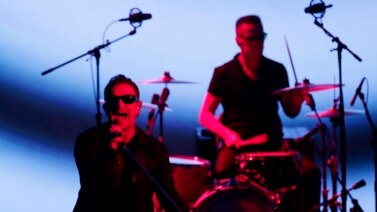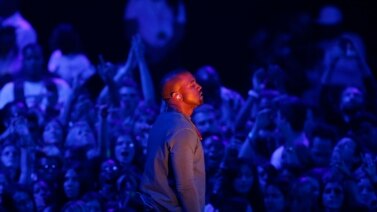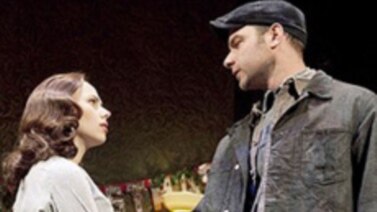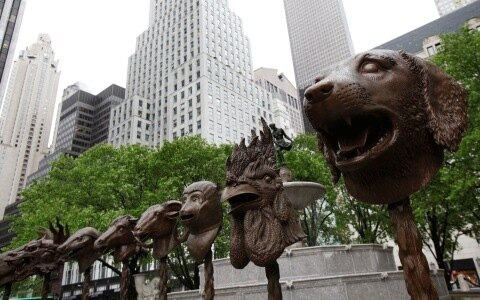
DOUG JOHNSON: Welcome to AMERICAN MOSAIC in VOA Special English.
(MUSIC)
I'm Doug Johnson. On our program this week, we play new music from Fleet Foxes…
And we answer a question about a term for a grouping of eight American schools…
But, first, we report on an exhibit that shows the work of a famous Chinese artist and detainee.
(MUSIC)
Ai Wei Wei Exhibit
DOUG JOHNSON: Last week, New York City Mayor Michael Bloomberg spoke at the opening of an exhibit of works by an internationally known artist. The artist lived in New York for several years and studied at Parsons the New School for Design. But he is not an American.
People gathered in New York’s Central Park to see works created by artist Ai Weiwei. He designed the Chinese National Stadium in Beijing, also known as the Bird’s Nest. But Ai Weiwei could not attend the ceremony. Faith Lapidus has more.
FAITH LAPIDUS: Twelve large bronze sculptures stand in the Pulitzer Fountain on the edge of Central Park. The sculpture exhibit is called “Circle of Animals/Zodiac Heads.” On a rainy day, Mayor Bloomberg opened the show with these words.
MICHAEL BLOOMBERG: “It's a bittersweet honor to welcome all of you here today to celebrate a remarkable piece of public art by one of the world’s most creative and courageous public citizens: Ai Weiwei.”
Ai Weiwei was arrested on April third as he prepared to fly from Beijing to Hong Kong. Relatives have not heard from him since. China’s foreign ministry refuses to release details of his detention.
Ai Weiwei is the son of Chinese poet Ai Qing. Ai Qing enjoyed great popularity in China until he was accused of being a political enemy of the Communist Party. He was then sent to China’s west for re-education. In the nineteen eighties, Ai Weiwei went to New York to study art. He returned to China in nineteen ninety-three.
Over the years, his fame as an artist grew in China. The two thousand eight Olympic Games were held in Beijing. Ai Weiwei worked with Swiss architects to design the Bird’s Nest stadium that became a symbol of the games.
Ai Weiwei gained widespread recognition at home for his artwork. But his ideas about free speech and human rights have led to problems with the Chinese government. He continues to be held on suspected economic crimes.
(SOUND)
Last month, a Foreign Ministry spokesman said foreign support for Ai Weiwei has confused and angered the Chinese people.
Many countries have condemned China’s detention of the artist. And critics say his arrest and the imprisonment of Nobel Peace Prize Winner Liu Xiaobo are part of a campaign against dissent and calls for reform.
The exhibit in New York is joined by two others in London and one in Berlin. Earlier this year, Ai Weiwei’s “Sunflower Seeds” or “Kui Hua Zi” opened at London’s Tate Modern museum. The idea was very simple, but carried out in a big way. The artwork is made of one hundred million hand-painted porcelain sunflower seeds.
Last week, an exhibition of the artist’s "Rock" and "Tree" opened at the Neugerriemschneider gallery in Berlin. Outside of the building, a huge sign read, “Where is Ai Weiwei?”
(MUSIC)
Ivy League
DOUG JOHNSON: This week, we answer a question from New Zealand. Erin would like to know what the term “Ivy League” means and where it came from.
The Ivy League is a name for eight schools in the northeastern United States. All but one were established hundreds of years ago, when England had colonies in the area. The oldest schools are Harvard, Yale, Columbia, Dartmouth, Princeton, Brown and the University of Pennsylvania. The newest is Cornell, which was founded in eighteen sixty-five.
The term Ivy League can also be used to describe a sports grouping of the eight schools. The schools are also called the Ivies.
Many language experts believe that the term first appeared in the media. In the nineteen-thirties, a sports reporter called the schools in the grouping, the “Ivy League.” The group also had an unofficial name -- “The Ancient Eight.” Now both names are used. However, the National Collegiate Athletic Association officially uses the term Ivy League.
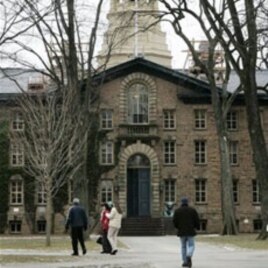
Why the reporter used the term is not completely clear. Some people say the term is linked to the ivy plant. And ivy does cover some of the grounds and buildings at the schools. Other people say the term dates back to when only four of the schools were part of the sports group. The number four was written in roman numerals, the letters “I” and “V.” However, most historians say that explanation is incorrect.
The term Ivy League is sometimes said in a disapproving way. Some people think the eight schools and their students value themselves too highly. Admission to the schools is very competitive. As little as seven percent of students who seek admission are accepted.
The educational offerings of Ivy League schools are considered among the best and most demanding in the world. All eight schools are also private and extremely costly. A four year degree from Harvard, for example, can cost more than two hundred thousand dollars. Admission to an Ivy League school can sometimes be easier among people who are rich, powerful or are related to former students of the school.
(MUSIC)
Fleet Foxes
DOUG JOHNSON: The band Fleet Foxes met with immediate success with its first album in two thousand eight. Billboard Magazine declared the record, also called Fleet Foxes, its Album of the Year. Critics from Rolling Stone compared the band to two great groups from the past, the Beach Boys and Crosby, Stills and Nash.
Recently, Fleet Foxes released its second album. Katherine Cole has more.
KATHERINE COLE: “Helplessness Blues” is the name of Fleet Foxes’ new album. The name might represent the difficulties the band experienced when putting the album together. The group had completed all the songs, but decided against them during the production process. Band member Robin Pecknold told Pitchfork.com that he then spent a year struggling to write new songs.
Here is the title song from the album, “Helplessness Blues.”
(MUSIC)

Robin Pecknold is the lead singer for Fleet Foxes. The six-member band is known for creating beautiful harmonies when they sing together. “Battery Kinzie” from “Helplessness Blues” is a good example.
(MUSIC)
Lead guitarist Skylar Skjelset and Robin Pecknold met in high school in the state of Washington. They both had musical parents. They also both loved musicians Bob Dylan and Neil Young. Robin Pecknold sounds much like Neil Young in the song “Grown Ocean.”
(MUSIC)
Right now, Fleet Foxes is performing at cities across the United States. The band plans to go Europe at the end of May for a concert series there.
We leave you with Fleet Foxes performing “The Cascades” from its new album “Helplessness Blues.”
(MUSIC)
DOUG JOHNSON: I’m Doug Johnson. Our program was written by Mario Ritter and Caty Weaver, who was also the producer.
Join us again next week for music and more on AMERICAN MOSAIC in VOA Special English.
(MUSIC)
